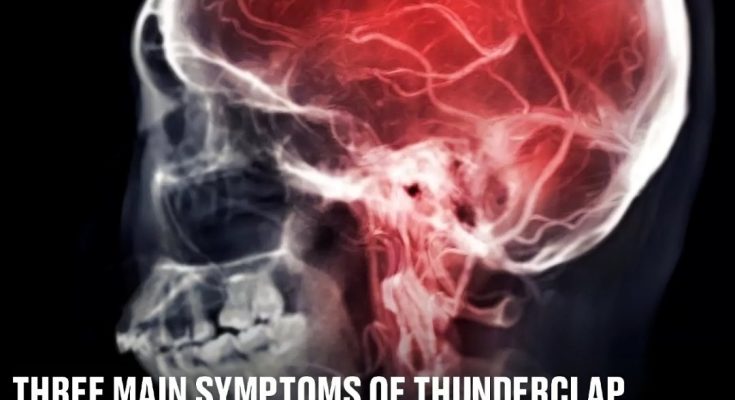We’ve all had headaches from time to time, often caused by dehydration, stress, or a sleepless night. While most headaches are harmless, there’s a rare and dangerous type called a “thunderclap headache” that demands immediate attention. This type of headache is no ordinary pain; it’s intense, sudden, and can be a sign of something far more serious. Recently, doctors have highlighted the need for awareness of thunderclap headaches, stressing that recognizing the symptoms could be life-saving.
In this article, we’ll discuss what makes thunderclap headaches so distinct, the symptoms to watch for, and why it’s crucial to seek medical help if you experience one.

What Exactly Is a Thunderclap Headache?
A thunderclap headache isn’t your average headache. As defined by the NHS, it feels like a sudden, blinding blow to the head, causing an intense pain unlike any other. Unlike other headaches that build up gradually, thunderclap headaches reach maximum intensity within seconds and can be deeply unsettling. Medical professionals consider these headaches a red flag, as they can be linked to life-threatening conditions such as brain aneurysms or hemorrhages.
The Sudden and Severe Nature of Thunderclap Headaches
Thunderclap headaches are named for their lightning-fast onset, much like a clap of thunder. They can come on without warning and cause intense pain within moments. Dr. Joe, a popular doctor and content creator on TikTok, describes these headaches as “the worst headache of your life”—a sudden, overwhelming pain that leaves you debilitated.
“Often, people don’t recognize the symptoms and think it’s just a really bad headache,” explains Dr. Joe. “But if it’s the sudden onset of the worst headache of your life, it’s something you need to seek medical attention for.”
The distinguishing features of a thunderclap headache make it essential for people to understand the symptoms and act quickly if they experience one.
Recognizing the Symptoms of a Thunderclap Headache
Identifying a thunderclap headache can be challenging, especially if you’ve never experienced one before. Here are the primary signs to look out for:
1. Sudden, Intense Pain
The most defining characteristic of a thunderclap headache is how fast it escalates. Unlike other headaches, which may start as a dull ache and grow over time, thunderclap headaches peak within 60 seconds, often reaching unbearable intensity. This abrupt pain is the first major warning sign that something is wrong.
2. Nausea and Vomiting
Severe headaches can sometimes lead to nausea and vomiting, which is also common with thunderclap headaches. If you experience sudden, intense pain along with a wave of nausea, it’s a sign that the headache could be serious and not just an isolated incident.
3. Neck Stiffness and Pain in the Shoulders
Thunderclap headaches can also bring pain to areas around the head, particularly the neck and shoulders. Dr. Joe highlighted this symptom in his video, sharing a story about a man who felt overwhelming pain in his head, neck, and shoulders following a fishing trip. Such spreading pain may indicate a more severe issue, like pressure or bleeding in the brain.
4. Seizures, Fever, and Mental Confusion
Other symptoms accompanying a thunderclap headache may include seizures, fever, and altered mental states, such as confusion or difficulty focusing. These symptoms can signal brain issues and should not be ignored.
Why Thunderclap Headaches Are So Dangerous

While not every headache needs medical attention, thunderclap headaches are an exception due to their potential link to life-threatening conditions. According to NHS guidelines, one of the most alarming causes of thunderclap headaches is a burst brain aneurysm, which occurs when a weakened blood vessel in the brain ruptures, causing bleeding.
Understanding Brain Aneurysms and Their Risks
A brain aneurysm is a weak spot in a blood vessel in the brain that can enlarge over time. Many aneurysms go undetected and don’t cause issues, but if one bursts, it can lead to a condition called a subarachnoid hemorrhage—bleeding on the surface of the brain. This is a severe, life-threatening emergency, as the brain’s delicate tissue can only handle a certain amount of pressure.
When blood flows into the subarachnoid space (the area around the brain), it can cause sudden, immense pain, and any delay in treatment can lead to long-term brain damage or even death.
Other Serious Causes of Thunderclap Headaches
While burst aneurysms are a primary concern, other possible causes of thunderclap headaches include:
- Cerebral Vasoconstriction Syndrome: A temporary narrowing of the brain’s blood vessels, which can restrict blood flow.
- Intracerebral Hemorrhage: A type of stroke caused by bleeding within the brain.
- Meningitis: A severe infection of the protective membranes surrounding the brain and spinal cord.
- Pituitary Apoplexy: A rare condition where a pituitary gland tumor suddenly bleeds, causing severe headaches and vision problems.
These conditions all require immediate medical intervention, making it critical to recognize and act on thunderclap headache symptoms quickly.
What to Do if You Experience a Thunderclap Headache
If you or someone around you experiences a thunderclap headache, don’t ignore it. Even if you’re unsure about the symptoms, it’s safer to seek medical assistance. Call emergency services or go to the nearest emergency room as soon as possible.
When to Seek Immediate Help
Here’s when you should seek medical attention:
- The headache strikes suddenly and severely, peaking within 60 seconds.
- You experience nausea, vomiting, neck stiffness, or changes in mental clarity.
- You notice additional symptoms, such as seizures or fever, which could indicate an infection or another critical issue.
By acting swiftly, you can ensure that medical professionals can diagnose and treat the underlying cause of the headache before it worsens.

Medical Evaluation and Diagnosis
Upon reaching a hospital, doctors will likely conduct a series of tests to determine the cause of the thunderclap headache. Common procedures may include:
- CT Scan: This imaging test can detect bleeding or swelling in the brain, a telltale sign of an aneurysm or hemorrhage.
- Lumbar Puncture (Spinal Tap): This test can identify blood in the spinal fluid, which can be a sign of a subarachnoid hemorrhage.
- MRI Scan: An MRI provides detailed images of the brain’s blood vessels, helping identify structural abnormalities or inflammation.
The goal of these tests is to identify the cause of the headache and administer treatment as quickly as possible, potentially saving a life.
Preventing Thunderclap Headaches and Knowing Your Risks
While thunderclap headaches can sometimes strike without warning, certain factors may increase your risk. Recognizing these risk factors and taking preventive steps can help reduce your chances of experiencing one.
1. Manage Blood Pressure
High blood pressure is one of the primary risk factors for brain aneurysms. If you have a history of hypertension, work closely with your doctor to manage it through lifestyle changes and medications, if necessary.
2. Avoid Smoking and Excessive Alcohol
Smoking and excessive drinking can weaken blood vessels, increasing the likelihood of developing an aneurysm. Avoiding these habits is one of the best ways to protect your brain health.
3. Know Your Family History
A family history of brain aneurysms or hemorrhagic strokes can increase your risk. If these conditions run in your family, consider discussing regular screenings or preventive measures with your doctor.
Take Thunderclap Headaches Seriously: Don’t Ignore the Symptoms
Thunderclap headaches are rare but serious. Recognizing the signs and acting swiftly can make all the difference in preventing severe complications. While typical headaches are often benign, the intense, sudden pain of a thunderclap headache warrants immediate medical evaluation.
As Dr. Joe pointed out, it’s crucial to know when a headache might be more than “just a bad headache.” By staying aware and understanding the warning signs, you can make informed decisions that could save your life or the life of someone you care about.
Conclusion: Awareness Is the First Step to Prevention
Thunderclap headaches are a medical emergency, signaling that something could be seriously wrong within the brain. Recognizing the symptoms, such as sudden, intense pain, nausea, neck stiffness, or changes in mental state, is critical. If you experience any of these signs, don’t hesitate—seek medical help immediately.
Understanding thunderclap headaches and their potential risks empowers you to take swift action. Knowing the difference between a typical headache and a life-threatening one can be life-saving, so remember: awareness and quick response are your best defenses against the dangers of thunderclap headaches.



